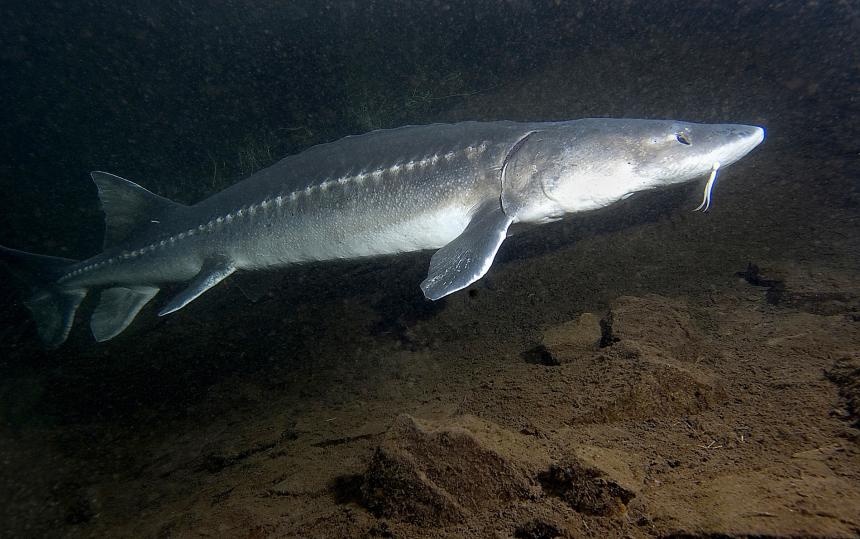Moderate
Description and Range
The white sturgeon is a large, prehistoric fish species native to Washington waters, found in rivers, coastal areas, estuaries, and Puget Sound. This iconic fish can grow to be extremely large and long-lived.
Physical description
White sturgeon can grow to more than 10 feet in length and weigh hundreds of pounds. They are also long-lived; some animals live to be 100 years or older, and typically don't reach sexual maturity until 15–25 years old.
Ecology and life history
White Sturgeon are amphidromous, meaning they can travel between freshwater and saltwater but it’s not a requirement to complete their life cycle. A majority of white sturgeon are thought to spend most of their time within the freshwater environment, however, a segment of each of population inevitably heads out to sea to distribute along the various coastal bays and estuaries that make up the West Coast.
White sturgeon are long-lived fish, and some individuals live to be 100 years or older. In the Lower Columbia River, white sturgeon typically reach sexual maturity when they grow to approximately 6 feet in length, or around 25 years old. Females are estimated to spawn every 4-6 years, and males are estimated to spawn every 2-3 years.
Geographic range
White sturgeon are native to the West Coast of North America. There are three primary spawning populations with access to the marine environment, including the Fraser River, Columbia River, and Sacramento-San Joaquin populations.
Climate vulnerability
Sensitivity to climate change
Moderate
White sturgeon likely exhibit physiological sensitivity to warmer water temperatures, and increasing temperatures may reduce spawning success and/or increase disease risk and mortality. White sturgeon are also sensitive to declining spring and summer streamflows, which reduce spawning habitat and annual recruitment; loss of spawning habitat and reduced recruitment associated with lower streamflows is a particular concern for impounded portions of the Columbia River. Shifts in ocean conditions may also affect prey availability for young white sturgeon in estuarine environments, and reduced prey availability has been linked with undermined sturgeon growth.
Exposure to climate change
Moderate
- Increased water temperatures
- Lower summer flows
Regulations
Rules and seasons
In part because of their exceptional life history, sturgeon are carefully managed and harvests closely monitored in the Columbia River, and the species is identified as a Species of Greatest Conservation Need under Washington’s State Wildlife Action Plan. More information on fishing regulations for White Sturgeon in Washington is available on the White Sturgeon regulations page.
While WDFW has conducted sturgeon monitoring in the Columbia River basin for several decades to better understand the populations of this fascinating and long-lived fish, the Department has lacked the resources to monitor in other areas, including Willapa Bay, Grays Harbor, and Puget Sound.
Recent biodiversity funding has enabled the expansion of these surveys into the Puget Sound and coastal areas, giving WDFW better data on the species’ distribution, abundance, size and age structure, and spawning in coastal and Puget Sound areas. This improved data will allow WDFW to better assess the conservation needs of sturgeon in these areas and will help inform future management of this species
Currently there is no recreational harvest of white sturgeon allowed in the Willapa Bay, Grays Harbor, or Puget Sound waterways or other coastal areas. However, catch and release only fisheries are open, when the season is open for salmon or game fish; except in the Snohomish River from the mouth to Highway 9 Bridge where it’s open year-round for catch and release only fisheries. The sturgeon fisheries in the Chehalis, Skagit, and Stillaguamish rivers in particular have a small but dedicated following among local anglers, many of whom care about sturgeon and appreciate this recreational opportunity.
Anglers who catch white sturgeon in these areas are encouraged to immediately release the fish and notify WDFW for improved data collection on this species.

